Termez
Termez
Termez (sometimes Termiz) is the most southern city of Uzbekistan, marking the border between Uzbekistan and Afghanistan at the northern side of the Amu Darya river (also known as Oxus). Most tourists come to Termez to cross to Afghanistan but it also presents a variety of attractive destinations and sights from old Buddhist monasteries to medieval mausoleums in its old town which is in the tentative list of Unesco World Heritage sites and should therefore not be neglected. There is plenty to see, all nestled inside a full curve of the powerful Amu Darya.
Termez is an archaeologically wealthy city. If you are a history fan, it is the perfect place to visit. In Termez, there are sites relating to the stories of Greek legionnaires, Buddhist monks, Arab and Mongol invaders, cosmopolitan traders and wandering men of wisdom and of course the Silk Road. Furthermore, the muslim builders of medieval times have left here some of their architectural gems. Today Termez is inhabited by more than 130 000 residents and has only few traces of its colorful cosmopolitan history. The town holds attractive landscapes on the edges of town as well as some ancient monuments and sites attesting to more glorious times.
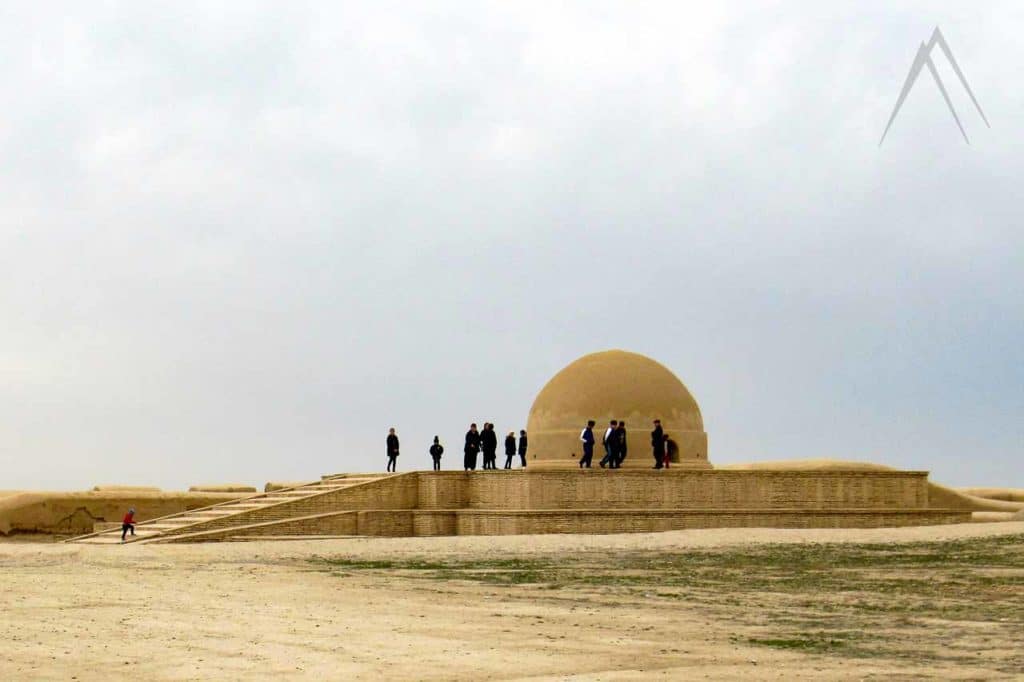
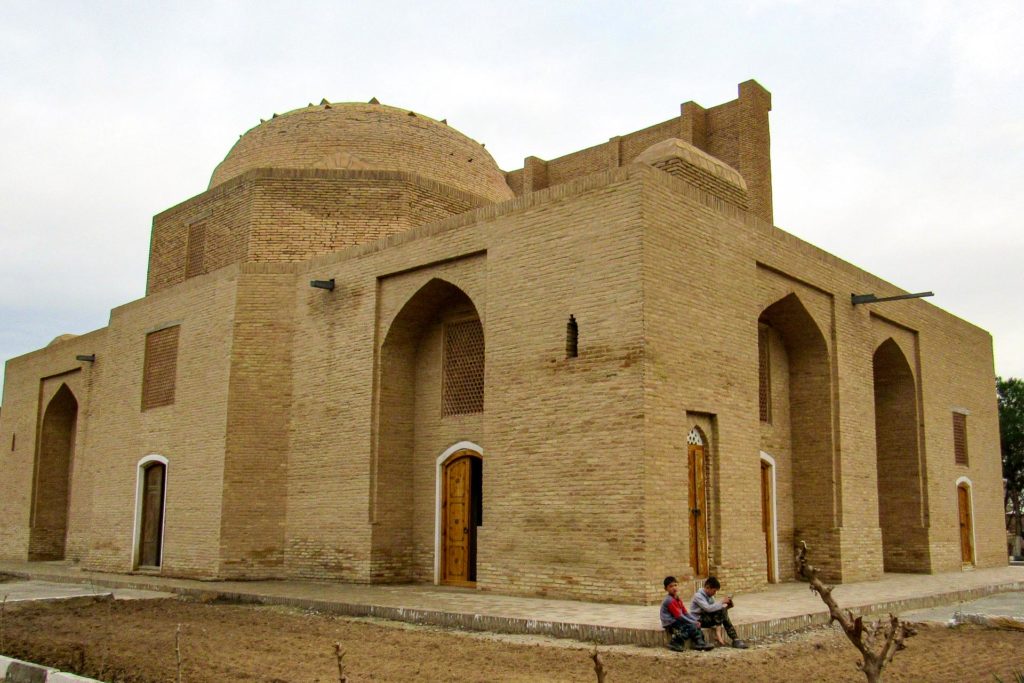
Throughout its glorious, epic history, Termez has performed the role of political and cultural chameleon, switching roles, religions, allegiances and even locations with the consummate ease of a circus performer. Across the centuries, bridges have become borders and then become bridges again, heartlands have faded to backwaters and cosmopolitan Silk Road junctions have shriveled into forgotten corners of a neglected republic.
History of Termez
The history of Termez starts from the conqueror Alexander the Great in the late 4th century BC. After Alexander′s conquest, the region became part of the Greco-Bactrian kingdom. As a Graeco-Bactrian city it flourished financially, culturally and spiritually at the meeting point of Mediterranean, Indian, Persian, Chinese and Central Asian civilizations. Termez became a center for Buddhism and Gandharan art, a fusion of Indian and Hellenistic styles. Greco-Buddhism developed in the region as a combination of Indian Buddhism and Greek culture.
Between the 1st and 4th centuries AD the entire region became part of the Kushan empire, under the patronage of which Buddhism spread further towards China. Following the fall of the Kushan empire and a series of more or less temporary rulers, the region became part of the Arab Caliphate in the 8th century. The Bactrian state eventually fractured and slid into decline, torn apart by warring factions. The Arab general Musa ibn Qasim seized Termez in 689 AD and proclaimed himself king, only to be overthrown by Caliph Uthman in 704 AD. From then onwards, Termez began to look north to Central Asia rather than south to Afghanistan. In the 13th century it was conquered by the Mongols of Gengis Khan and the Old Termez city was razed. The contemporary city of Termez rose up in the 14th century as part of the Timurid empire, a few kilometers southeast of the old location.
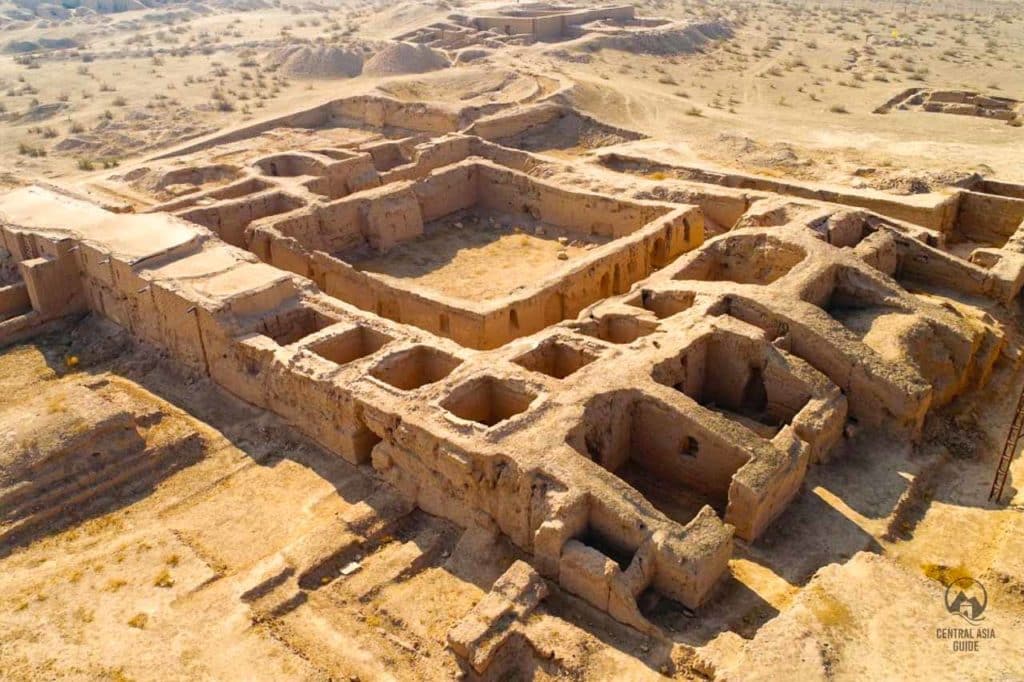
The third and current city of Termez is a 19th-century creation developed from a Russian garrison town on the southernmost border of the Russian Empire. A naval base was built on the river at nearby Chardzhou and military boats monitored the border closely. For 80 years or so Termez was one of the furthest and most sensitively sealed outposts of the Soviet empire, enforcing an unnatural religious cutoff point between Islam and atheism.
From the mid-1990s, it marked Uzbekistan’s frontline with militant Islam, until the fall of the Taliban in next-door Afghanistan rekindled hopes of a booming Silk Road commerce. Termez is off the beaten track for sure but a wide variety of Islamic and especially pre-Islamic sights await the well-informed visitor, as does the frisson of excitement that comes from such proximity to the Oxus (Amu Darya) and the Afghan border.
Termez is an attractive destination and it is pretty well connected with other destinations within Uzbekistan but the journeys are quite long. For instance, the distance with Samarkand is around 375 km, Bukhara 380 km, Tashkent 660 km, Khiva 855 km and Namangan 900 km. If you are traveling from Termez to Afghanistan you will need to cross the Termez-Hairatan border point. Termez is often also the first destination for visitors who have crossed the border from Dushanbe in Tajikistan.
Termez sights
Central Termez
Modern Termez
From the first glimpse, the modern Termez reminds an ordinary Soviet city with its cold heart and central square behind the Hokkimyat, once surveyed by a large statue of Lenin and the scene of many an epic bypass of Soviet war machinery. The contemporary city of Termez rose in the 14th century as part of the Timurid empire, a few kilometers southeast of the old location. Later when Russia annexed the Bukhara Khanate/Emirate in the 19th century, it became a major frontier town on the Russian southern border even further south. Modern city of Termez doesn’t attract as much as its region which is dotted with both Buddhist ancient structures and therefore most tourists use it as a base to explore the surrounding region.
Archaeological Museum
As one of the oldest cities in Central Asia Termez has preserved unique architectural monuments of the Kushan period of whic especially Airatam Buddhist temple complex is highly valued. Various excavations in the Termez region have revealed ancient archaeological findings of the Greco-Bactrian and Kushan periods that are today presented in the Termez Archeological Museum. This museum certainly deserves a visit. Exhibitions are focused on the Buddhist period and the early centuries AD. Within the collections you can see the household pieces like dishes, utensils and many other things such as weapons, both ancient and medieval, coins and stamps of rulers, etc. Furthermore, there is a large collection of paintings and antique sculptures also from the Greco-Bactrian and the ones discovered in ruined monasteries of the Kushan period.
Sultan Saodat Complex
Sultan Saodat Complex is located 8 km northeast of the modern Termez. The complex contains the collection of seventeen mausoleums that comprise of the family burial place of the Termez sayyids, a family dynasty claiming being descent from Ali, whose considerable political and religious power reached a peak during the 13th and 14th centuries. They were politically powerful, exceptionally influential in religious matters, and wealthy to boot, enabling them to leave this lasting legacy. It is said that even Tamerlane numbered among their followers. The founder of the dynasty, Sayyid Hasan al Emir, grandson and fifth in line from the prophet Mohammed, was buried here in the ninth century and set a precedent that his descendants were to follow for the next nine centuries. The two original mausoleums are widely attributed being the magnet that attracted the settlement of post-Mongol Termez.
There are 17 brick tombs on the site, most of which date from the 9th to 16th centuries, and they are organized along a street not dissimilar to the Shah-i Zinda in Samarkand. They would once have been richly tiled, though despite renovation, little such decoration remains, except for on the portico of a single tomb at the end of the street. It’s a striking focal point amongst the otherwise mud-brown facades. The mausoleums form a long, rectangular street of plain-brick tombs, turned in upon themselves and dominated at the western end by the two earliest tombs, of which the larger northern building is the earlier. The latest renovation of the complex took place in 2002. Photos by shagayu_po_tashkentu.

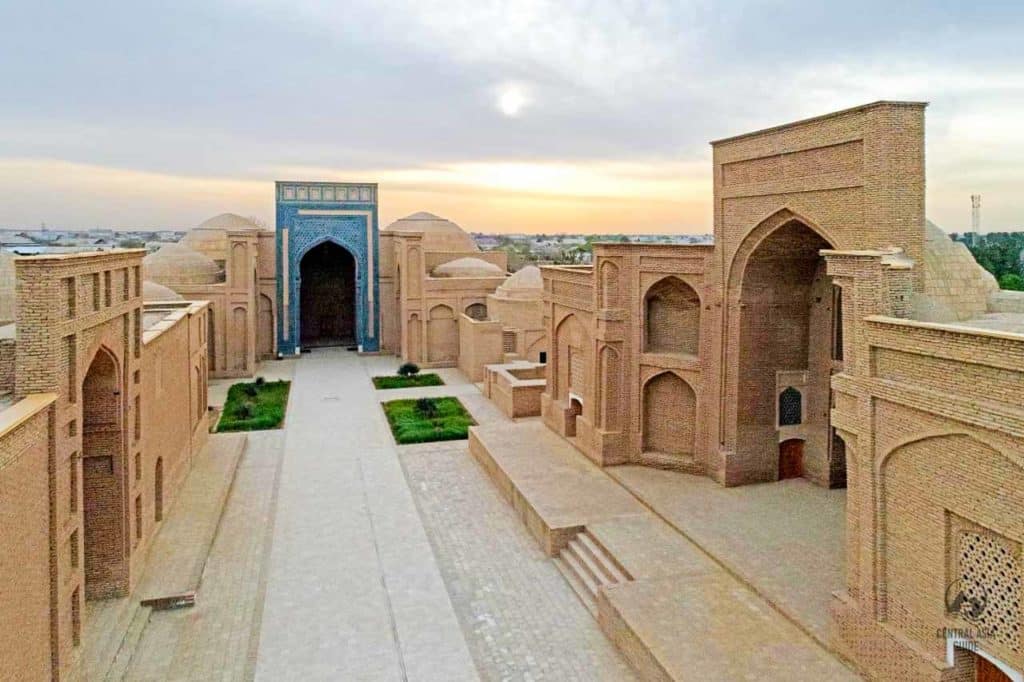
Kirk Kiz Fortress
The complex “Kirk Kiz” is located 3 km from the ancient city of Termez, just past the airport to the northeast of modern Termez. The story behind the name has sadly been lost in times but the options include 40 daughters, 40 virgins or 40 girls in a harem variously abstaining, avenging or procreating depending on the fantasy of the particular storyteller. The most popular of the legends is related to the well-known national legend in which the princess Gulaim and her forty girls bravely struggled against raiding nomads.
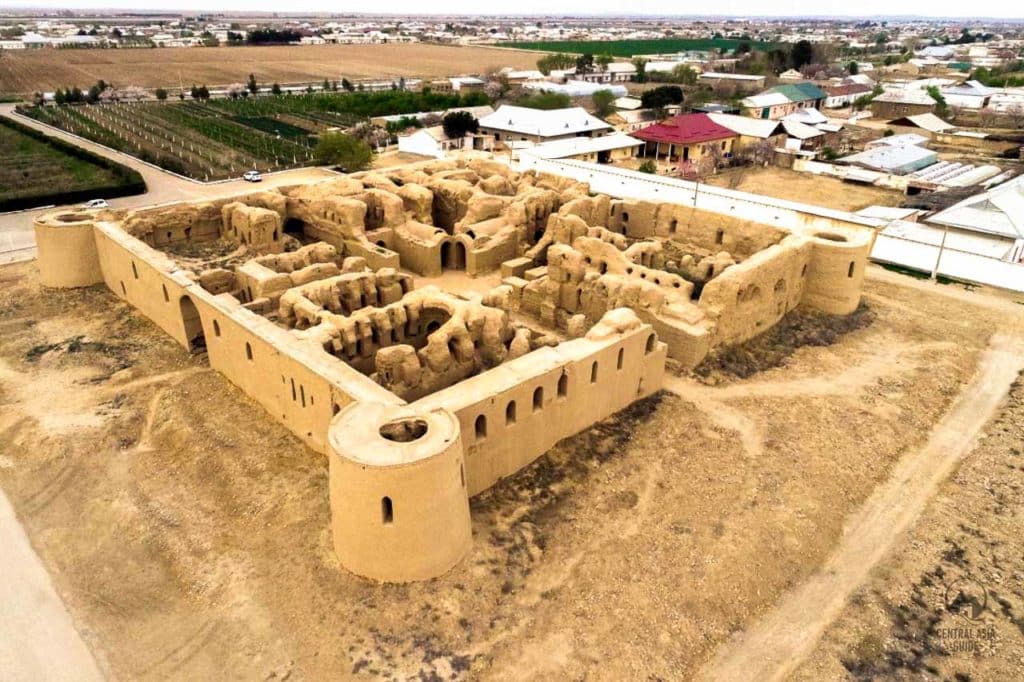
Everywhere in Central Asia legends based around a shadowy ’40 girls’ are endemic. Whether describing the 40 Amazonian daughters of a local Mongol ruler, the exploits of the poor Central Asian soul held captive in his fortress by his 40 nubile young serving girls or even the original 40 girls held responsible for the progeneration of the entire Kyrgyz race, the core of the legend of the 40 girls or Kyrgk Kyz, has long since been lost.
The fortress qyrq qyz dates back to the 9th century and it is typical of the style of such structures built just prior to the Arab invasion. Thick, mud-brick walls ran 55 m on each side of a square and encompassed some 50 rooms over two floors. Enough remains that you can wander from one obvious room to the next and if you take a guide they will be able to explain the likely function of each space and to imagine the former grandeur of the fortress. Historians and architects believe that there was once a dome over the fortress. Photos by shagayu_po_tashkentu.
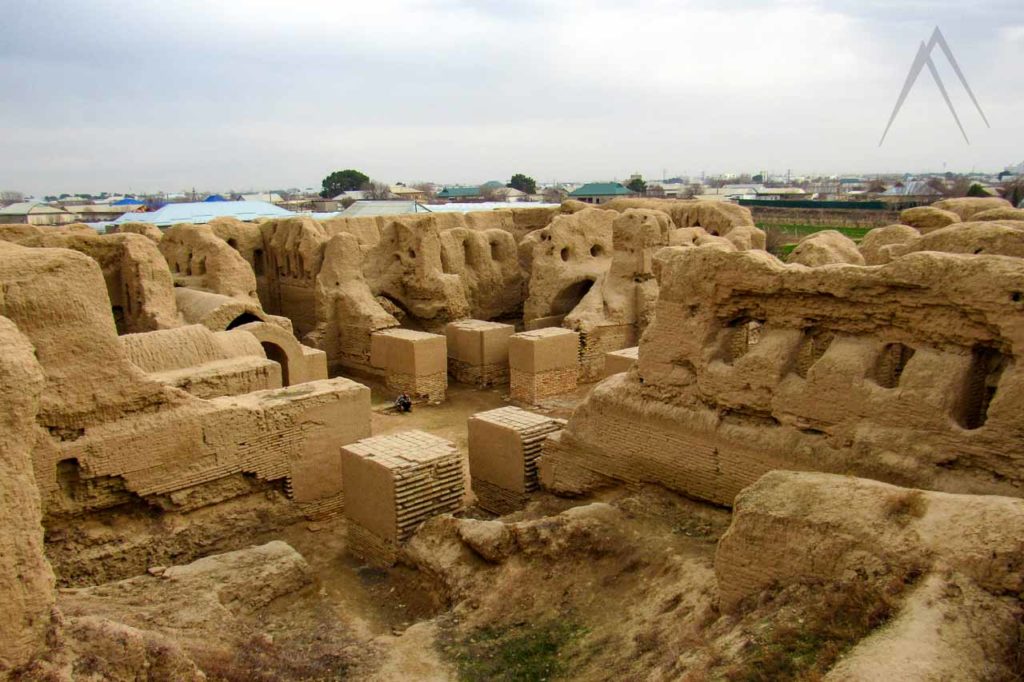

Northwest Termez
Old Termez
The original old city of Termez rests 6 km northwest of the modern Termez, on the north branch of the Amu Darya River. Old Termez was divided by walls into two sectors – Shahristan (city) and Rabad (suburb) occupying more than 500 hectares and a canal once ran through the entire city, which served as the main source of water for local residents. Two sides were further divided to four parts, one being the citadel Qala and the others used to house artisans, blacksmiths, potters, foundry masters and so on. Today only tiny parts of the walls of the early ancient citadel remain. It seems that the Mongols surely knew how to raze a town in 1220. You can still get an impression of the scale and strength of this settlement, which once hosted not only houses, shops and bazaars, but also a mint, caravanserais, orchards and a sophisticated network or irrigation canals. Termez was an important staging post on the caravan route connecting Central Asia with Balkh and India.
During the reign of the most ancient dynasty of the Kushan kingdom, the city acquired the name Termit, after which it became the largest religious and administrative center of Northern Bactria. The Kushan rulers adhered to religious tolerance and along with other religions, Buddhism was revered and flourished. Furthermore, In the Kushan period, the large administrative and ideological center of the Northern Bactria was the city of Tarmit with several Buddhist monasteries – Fayaztepa and Qoratepa. The Kushan rulers adhered to religious tolerance, here, along with other religions, Buddhism was revered and flourished.
Today several Buddhist monasteries have survived on the territory of the settlement, including the Karatepa cave temple complex and the sacred Fayaztepa monastery. These ancient monumental structures had shrines and stupas for storing Buddhist relics. All of them were decorated with ancient paintings, sculptural images of Buddha and the rulers of those times. For more information see the separate page from link below.
Southeast Termez
Afghanistan–Uzbekistan Friendship Bridge
Ironically called the Bridge of the Friendship, was built during the Soviet time and is located 16 km east of Termez crossing the Amu Darya as the main international border crossing between Uzbekistan and Afghanistan. The bridge was the main entry point for the Soviet troops who poured into Afghanistan in 1979 and also the exit point for the remnants who limped home ten years later under the leadership of General Gromov.
Residents of Uzbekistan and Tajikistan were initially targeted for conscription into the war, often called the Soviet Union’s Vietnam, in a move designed to win over the ethnic Uzbeks and Tajiks who make up the dominant ethnic groups in Northern Afghanistan. However, when confronted with their ethnic and religious brothers, many Soviet Uzbeks felt fundamentally torn allegiances and after few years, the policy was rejected. The asphalt square next to the border crossing was the former parade ground of the Soviet troops and several nearby graves remember young Russians buried far from home. Political sensitivities mean that you probably won’t get near the bridge without an Afghan visa.
Travel to Termez
Termez by Plane
There are twice a day flights from Tashkent to Termez via Uzbekistan Airlines. The flight time is 1h 45min and it cost about 80 US dollar.
Termez Airport is about 20 min drive away from the city center north side of city center. You can get there by the minibus number 11 from the main bazaar.
Termez by Train
The train bnumber 379 operates from Tashkent every other day to Termez taking about 14 h. There are also regular services to Denau with 3 h trip. Termez train station lies in the northern end of city and you easily walk there from the city center.
There is also a straight train from Termez through Denau to Dushanbe, Tajikistan. Tickets must be bought online.
Termez by Bus / Taxi
There are daily busses operated from Tashkent (13h) and Samarkand (9h). There are also shared taxis that are more expensive but faster. If you are leaving from Termez to other cities, it is best to get buses in the early morning.
Termez bus station is located in the city center at the western end of Navoi street.
Sights & destinations near Termez
Page updated 30.12.2020